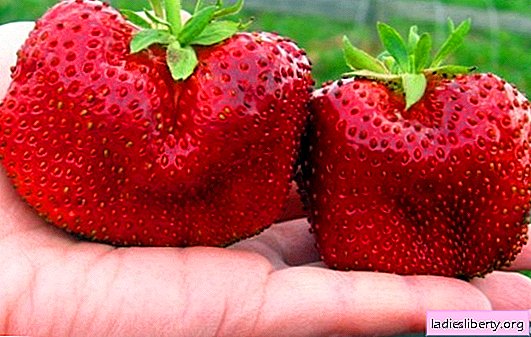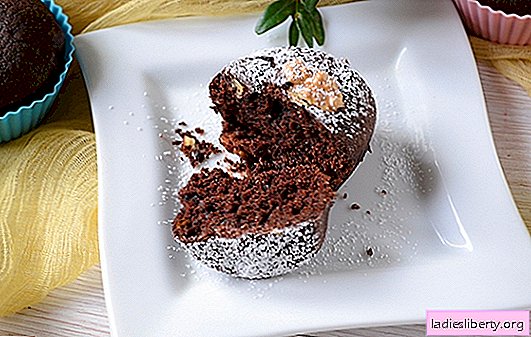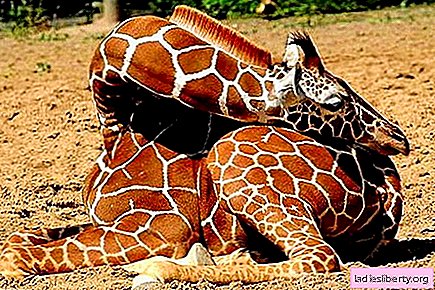
The large-fruited strawberry variety with the aroma of wild berries is Chamora Turusi. Productivity of a grade surpasses Queen Elizabeth known to all strawberries.
With good care from one bush, it is possible to collect more than 2.5 kg of berries. How to grow this new variety, you will learn further.
All about the Chamorora Turusi variety: the origin of strawberries and their characteristics
Garden strawberries with giant fruits "Chamorora Turusi" has two more names "Turush" and "Kurusi". But actually it is one grade. Its exact origin is not known. Presumably, strawberries were brought into Russia from Japan, but some breeders believe that this is a successful hybrid of the famous varieties Queen Elisabeth and Gigantella Maxim. Be that as it may, the fruits of this berry are clearly superior to the parental forms. The weight of one strawberry is more than 150 grams, and this is not enough. For example, the weight of an average apple is from 120 to 160 grams.
The variety belongs to mid-season, the first berries ripen in early June. Fruiting extended until the beginning of July. The quality of the berries and the amount of yield depends on the care of the bushes during this period.
The peak yield occurs in the second or third year of cultivation, but in the first year it is better not to let the bushes bloom. From the fourth year, the berry gradually grows smaller, so it is better to transplant strawberries to a new place. But for a subsidiary, a berry weighing 80-100 grams is also considered a good indicator. With constant care and proper care, Chamorora Turusi is able to grow and bear fruit in one place for more than 20 years, although yield indicators will be lower.
Detailed description of strawberries "Chamorora Turusi" and the dignity of the variety
Bushes of this variety are quite powerful, form a thick, spreading crown. The leaves are dark green, juicy, a lot of mustaches. The variety is characterized by intensive growth. The young planted this year in two months is gaining its maximum size.
The berries are round, ribbed. As mentioned earlier, very large. In the process of ripening, they acquire a dark red color and a pronounced strawberry aroma. The ripe the berries, the more fragrant it is. The pulp is sugary, tasty.

The undoubted advantage of this new product is the high transportability of berries. Strawberries tolerate long transportation, which makes the variety valuable from a commercial point of view. But this is not all the advantages of culture:
• strawberries are suitable for freezing, preservation, desserts, jams;
• tolerates frosts and temperature changes;
• resistant to powdery mildew;
• does not require top dressing;
• long keeps a trade dress.
However, with all the advantages, the variety has disadvantages. The bushes do not tolerate drought at all, the berry becomes dry. But waterlogging of the soil is detrimental to the culture, the root system rots. In addition, the variety is affected by fungal diseases: spotting, verticillosis, gray rot. With high humidity, the fruit eats slugs and snails. In a dry climate, it is affected by a tick. It grows poorly on poor soils.
Features of planting varieties and growing strawberries "Chamorora Turusi"
The most important thing at the growing stage is to find a quality planting material that has been grown in accordance with all the rules. A lot of space is allocated for planting varieties to prevent the appearance of pests and diseases. The site should be well lit by the sun, but from gusts of strong winds it must be fenced. The best solution would be to plant in an open area between rows of shrubs.
Particular attention should be paid to the soil, since the culture grows well and bears fruit only on loose, fertile soils. Under digging, phosphate-potassium fertilizers, chernozem, chicken droppings or mullein are added to the garden bed. Prepare the soil in the fall. Good predecessors for strawberries are cabbage, legumes, cereals, onions.
Advice! Do not use a lot of nitrogen-containing fertilizers, as this leads to an increase in green mass, but adversely affects the fruiting of the culture, provokes the appearance of fungal diseases.

Seedlings are planted in autumn or spring. It depends on the region of cultivation. In the middle lane and northern regions, landing is carried out at the end of August. In the south of the country young growth can be planted in spring.
When planting, they adhere to the 40 x 60 cm pattern, since the crown of an adult plant spreads out 0.5 m. If the distance between the bushes is reduced, the root system will not get enough nutrition, the berries will be shallow, and the risk of fungal diseases increases. Wells form a depth of more than 15 cm, the bottom is well drained so that there is no stagnation of moisture. The sparse planting method facilitates further care of the bushes.
How to properly care for the Chamorora Turusi variety so that the strawberries produce a good harvest
As already mentioned, garden strawberries prefer moderately moist soil. It is best to grow it on a drip irrigation system, but you can do without it.
Watering organization
In the spring, old mulch and last year's foliage are removed from the beds. In late April or early May, depending on the weather, the garden can be watered with warm water. Strawberries consume up to 0.5 l of water per bush. During this period, it is enough to moisten the soil once a week. If the weather is rainy, then the bushes will be enough natural moisture.
In summer, watering is more plentiful, especially in the heat and at the time of berry formation. Sometimes daily watering is allowed, but try not to get on the leaves of the plant. Watering strawberries is best from a watering can, hose or drip system.
Advice! Fertilizing in the first two years can not be carried out if the beds were properly prepared.
Pruning
At the end of fruiting, the bushes need pruning to reduce the risk of developing diseases and the appearance of pests. Secateurs remove not only leaves, but also a mustache. The "heart" of the bush, that is, the growth point is left untouched. Until autumn, the bushes will grow young leaves with which they will winter. After pruning, the beds are loosened, trying not to damage the root system of the plants, a new layer of peat, sawdust or straw is poured. This technique helps to maintain moisture in the soil.
This is what strawberries look like after pruning.

Top dressing
After the second year of cultivation, top dressing is used so that the berry does not grow smaller, and the bushes continue to develop well.
Garden strawberries are fed in several stages:
• before laying flower buds in spring;
• at the time of formation of the ovary;
• after fruiting;
• before wintering.
For the first time, strawberries are fed in the spring, after harvesting the beds. At this point, it is better to fertilize with a fraction of nitrogen, so that the bushes start growing, and enough foliage grows.
With the advent of the ovary, they switch to phosphorus-potassium fertilizing. It may be a solution of ash. It not only improves the taste of berries, but also contributes to their ripening.
After harvesting, they are fed with nitrophos and mullein. For winter, the garden is mulched with humus or manure.
Propagation of strawberries "Chamorora Turusi" at home
The variety is well propagated by mustache and dividing the bush, but it is not possible to take planting material from each plant. There are some peculiarities.
For breeding, uterine plants are chosen, they must be large and healthy. Most importantly, the bushes are not allowed to bloom and bear fruit, otherwise they spend energy on the crop. High-quality seedlings from such bushes will not work.

It is easier to propagate strawberries with a mustache. To do this, only the very first large sockets are left on the selected bushes. They are grown on the mother plant until next spring, and only then transplanted to a permanent place. In autumn, it is better not to separate young plants, otherwise they may die during the cold season.











